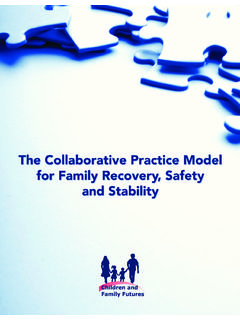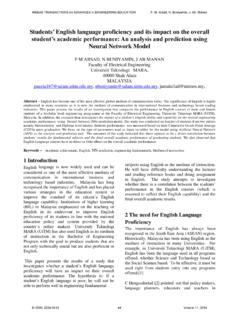Transcription of Bioterrorism Introduction - - RN.org®
1 Bioterrorism Introduction Reviewed October, 2018, Expires October, 2020 Provider Information and Specifics available on our Website Unauthorized Distribution Prohibited 2018 , , , LLC Course Objectives Explore and define the role of the healthcare worker in the event of Bioterrorism . Explain the roles of the various government agencies and managing a disaster. Define the basic signs and symptoms of the five major weapons of mass destruction. To provide clinicians and public health officials with the following information related to ricin: Background, Clinical Presentation, Recognition and Diagnosis, Personal Protective Equipment/Decontamination, Management, and Reporting. To provide clinicians and public health officials with information on epidemiological clues that may suggest illness associated with ricin or another chemical or biological toxin in the correct clinical context.
2 Upon successful completion of the program, participants should be able to: Describe the epidemiology of nonterrorism-associated ricin poisoning. Describe the epidemiology of terrorism-associated ricin poisoning. Describe the clinical manifestations of oral, inhalational, and parenteral ricin poisoning. Describe the differential diagnosis for ricin poisoning. Explain the diagnosis of ricin poisoning. Identify epidemiological clues suggestive of a possible covert ricin (or other chemical/biological toxin) release. Describe the clinical management of ricin poisoning. Describe the disposition of patients with ricin-associated illness. And identify the proper authorities for reporting of suspected or known ricin- associated illness. PART 1 Introduction The events of September 11, 2001, have increased concern about the potential use of biological, chemical, and nuclear weapons by terrorists.
3 Medical and public health professionals will be the first respondents and they must be proficient in the recognition and management of these agents. The purpose of this course is to inform and educate attendees about biological, chemical, and nuclear events, specifically to (1) identify biological pathogens of concern for use in warfare or terrorism and the characteristics that make a biological pathogen an effective weapon; (2) describe the epidemiology, clinical features, medical management, and available treatment of potential medical problems derived from the use of biological, chemical, and nuclear weapons; and (3) understand the role of organized medicine in the national response to terrorism. History and Overview of Weapons of Mass Destruction Weapons of mass destruction (WMD) have been around since the 1700s, are easy to build, easy to hide, and pose a great threat.
4 They are classified into three categories: chemical, nuclear, and biological. Weapons of mass destruction are attractive to potential terrorists because they create fear; are inexpensive; cause no damage to land or equipment; are difficult to detect; usually have no immediate clinical signs, ie: no burning on contact, invisible, and no taste or smell; and exhibit a delayed onset of symptoms -- nerve agents within minutes, vesicants within hours, and biological agents within days. With WMD, protection of large areas and large numbers of people is impossible. The disadvantages to WMD are contempt, retaliation, and prohibition treaties (all of which are now being ignored); danger during deployment due to accidents and no control over the wind; and the persistence of some agents. Selected Facts About Anthrax Efficiency 30 kg anthrax spores = 30,000-100,000 deaths; 1,000 kg atomic bomb = 23,000-80,000 deaths.
5 Aircraft aerosol delivery of 100 kg anthrax spores on a clear, sunny day with a light breeze would result in 130,000-460,000 deaths; on an overcast day or night with moderate wind 420,000-1,400,000 deaths; and on a clear, calm night 1-3 million deaths. Risks to healthcare workers include unsuspected agents, incomplete decontamination, inadequate ventilation, and recent trend toward second bomb targeting responders. Diagnosis via gram stain, DFA, and culture. Cutaneous clinical - necrotic lesion that spontaneously heals (85%); Inhalation clinical -- 1- to 3-day incubation with fever, dyspnea, hemorrhagic mediastinitis and hypotension leading to death. Selected Facts About Cyanide Inhibits cellular respiration by binding to the hemoglobin iron in the final step of the electron transport chain.
6 Lethal plasma concentrations can be obtained quickly via the respiratory route. Cyanide is detoxified via rhodanese and b-Mercaptopyruvate-cyanide-sulfur transferase. Therapy: sodium nitrite bolus 300 mg dose given over 3 minutes to produce methemoglobin (usually >10%); sodium thiosulfate bolus dose ( gm given over 10 minutes) to detoxify. In a mass causality situation the use of standard therapy would be difficult at best. Expected toxicity of WMD is as follows: Organophosphate nerve agents -- rapid acting, acute and chronic CNS symptoms. Mustard gas -- delayed toxicity >24 hours; skin, eyes, and pulmonary Cyanide -- rapid acting Botulism -- 24-72 hours, needs extensive medical support, <10% fatality Anthrax -- 1-7 days, >95% fatality (inhalational). Mitigation Mitigation involves limiting contamination to existing casualties, preventing new casualties, achieving early decontamination (within minutes), isolating/protecting area of contamination, ventilating transportation and treatment areas, and watching for a "second bomb.
7 " Prompt treatment provides best outcome; successful treatment requires rapid identification of agents; late treatment requires supportive care and anticipation of sequelae of agents; and time and manpower demands will be intensive. Prosecution requires collection of evidence from site and is often forgotten by healthcare providers. Reassessment includes learning from experience, identifying vulnerabilities/creating contingency plans, and including new personnel/obtaining their support. The US policy on counterterrorism includes (1) the Presidential Decision Directive 39 (PDD-39) of 1995, which designates FBI as lead agency in crisis management response, FEMA as lead agency in consequence management response, and requires all federal agencies to support the Federal Response Plan; and (2) Defense Against Weapons of Mass Destruction Act (Nunn-Lugar-Domenici Bill) of 1996, which required the Secretary of Defense to establish a program to advise and train federal, state, and local officials until 1999 and allows the President or Attorney General to request military support for local authorities in chemical/biological incidents.
8 Bioterrorism : Threat Potential and Readiness Strategies The US has dealt with WMD and biological warfare in the past but is now facing a composite continuum of issues concerning domestic biological terrorism. Terrorism acts since the early 1990s, including the Oklahoma City bombing (and a potential for more), have resulted in a new emphasis on WMD and a policy on counterterrorism. This type of event has been studied, anticipated, and practiced for five years; the new war is now a reality. A briefcase full of anthrax cannot be shot down. Medical personnel have a new role; the frontline force of protection and defense is medical in this new war. The vulnerability of the US lies in the fact that protecting large areas and large numbers of people is impossible. The US is a country of "haves" in a world of "have- nots"; this has made the US a prime target, and the war will not be over in the foreseeable future.
9 Potential Bioterrorism agents include Bacillus anthracis, Yersinia pestis, Coxiella burnetii, Ebola virus, Vibrio cholerae, and Clostridium botulinum. Recent events involving the weaponization of anthrax have resulted in 5 fatalities and 11 confirmed inhalational cases. It is estimated that at least 32,000 individuals have taken ciprofloxacin HCl (CIPRO, Bayer Corporation) in response to the threat posed by the distribution of anthrax spores through the US mail. For several years, anthrax has been recognized as a potential biological threat to military as well as civilian populations. The causative organism of anthrax, Bacillus anthracis, occurs naturally, is relatively easy to access, is extremely resilient (in the spore form it may live for up to 50 years in soil), and is relatively inexpensive compared to conventional weapons.
10 Anthrax spores range in size from 2 to 5 microns, just a fraction of the diameter of a human hair. Even a small number of anthrax spores, enough to fit on the head of a pin (approximately 5,000 to 8,000 spores), is sufficient to cause the inhalational form of anthrax. The inhalational form of anthrax is difficult to diagnose in the earliest stages, difficult or impossible to treat once clinical signs become apparent, and may allow only hours for therapeutic intervention. Its efficiency and low cost make anthrax accessible to virtually any group, including non-nation/state terrorists. The anthrax organism that has been dispersed through the US mail appears to be a conventional strain of anthrax and is not known to be recombinant or genetically altered. The protective antigen in anthrax binds with other proteins produced by the organism (edema factor and lethal factor).















